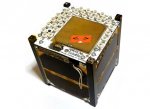Although long traditional, & readily identified with eyes/binoculars,visible light signalling is probably not a wise use of limited transmitter energy. It may be quaint in this application, but satellite orientation,outdoor "heads up" viewing & clear night skies are crucial.
In contrast a few Watts of VHF from above would be easily detected on even a $$ receiver, & could be heard night & day, for a longer pass, under cloudy skies (& perhaps even indoors) with the data readily recordable/machine decoded. Naturally some Doppler frequency shift may arise, but this is now readily handled.
Although wide band receivers & decent antenna are needed for
analog picture decoding, a cheap hand held scanner with just a mere rubber duckie whip antenna can readily detect passing NOAA weather satellites (WXsat) on ~137MHz.
Such VHF satellite transmisions are "ancient" technology! Back in 1958 signals from the US "Explorer 1" were sent to the ground by a pair of (then leading edge)
transistor transmitters - one a 60 mW (with internal antenna) on 108.03 MHz, & the other (feeding 4 flexible external whips) a mere 10 mW on 108.00 MHz. In 1962
OSCAR 1 (Orbital Satellite Carrying Amateur Radio) sent Morse ..../.. ("HI") at ~146MHz.
Stan (ZL2APS since 1967)





